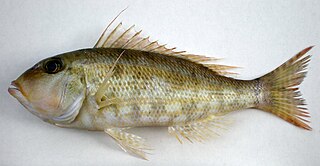
The daggertooth pike conger also known as the darkfin pike eel in Australia, to distinguish it from the related pike-eel, is a species of eel in the pike conger family, Muraenesocidae. They primarily live on soft bottoms in marine and brackish waters down to a depth of 800 m (2,600 ft), but may enter freshwater. They commonly grow to about 1.5 m (4.9 ft) in length, but may grow as long as 2.2 m (7.2 ft). Daggertooth pike congers occur in the Red Sea, on the coast of the northern Indian Ocean, and in the West Pacific from Indochina to Japan. A single specimen was also reported in the Mediterranean Sea off Israel in 1982.
Capillaria philippinensis is a parasitic nematode which causes intestinal capillariasis. This sometimes fatal disease was first discovered in Northern Luzon, Philippines, in 1964. Cases have also been reported from China, Egypt, Indonesia, Iran, Japan, Korea, Lao PDR, Taiwan and Thailand. Cases diagnosed in Italy and Spain were believed to be acquired abroad, with one case possibly contracted in Colombia. The natural life cycle of C. philippinensis is believed to involve fish as intermediate hosts, and fish-eating birds as definitive hosts. Humans acquire C. philippinensis by eating small species of infested fish whole and raw.

The Anisakidae are a family of intestinal nematodes (roundworms). The larvae of these worms can cause anisakiasis when ingested by humans, in raw or insufficiently cooked fish.

Capillaria is a genus of nematodes in the family Capillariidae .

Like humans and other animals, fish suffer from diseases and parasites. Fish defences against disease are specific and non-specific. Non-specific defences include skin and scales, as well as the mucus layer secreted by the epidermis that traps microorganisms and inhibits their growth. If pathogens breach these defences, fish can develop inflammatory responses that increase the flow of blood to infected areas and deliver white blood cells that attempt to destroy the pathogens.
Myleusnema bicornis is an intestinal parasite of Myleus ternetzi, or "Ternetz's Silver Dollar", a freshwater Characoid fish commonly found in the French Guiana river. M. bicornis has several unusual morphological characteristics, namely the two postcloacal "horns" in the posterior of males, and a separate elongated cephalic region (head) that may be extended and retracted. These features differ vastly from other Cosmocercoidean nematodes, as well as any others within the family Kathlaniidae, and as such necessitate the creation of the new genus Myleusnema; however, no genetic taxonomic studies have been performed.

Paracapillaria is a genus of parasitic nematodes. Species of the genus Paracapillaria parasitise fishes and amphibians, reptiles (snakes), and a single species, Paracapillaria philippinensis(Chitwood, Velasquez & Salazar, 1968), is known from birds and mammals including man.

Capillariidae is a family of parasitic nematodes. All its members are parasites in vertebrates when they are in their adult stage.

The Trichosomoididae is a family of nematodes.

Lethrinus rubrioperculatus, common names the spotcheek emperor, red-eared emperor, red-ears, red-edged emperor, scarlet-cheek emperor, and spot cheek emperor, is a species of emperor fish.

Philometra is a genus of nematodes, which are parasites of marine and freshwater fishes. The genus was erected by Oronzio Gabriele Costa in 1845.

Huffmanela hamo is a parasitic nematode. It has been observed in the muscles of the dagger-tooth pike conger Muraenesox cinereus, a muraenesocid marine fish off Japan. Its life-cycle is unknown.

Pseudorhabdosynochus is a genus of monopisthocotylean monogeneans, included in the family Diplectanidae. The type-species of the genus is Pseudorhabdosynochus epinepheli .
Philometra priacanthi is a species of parasitic nematode of fishes. Its name is derived from its host species, Priacanthus hamrur. It possesses dorsal lamella-like structures on the distal part of its gubernaculum, which can also be found on other of its cogenerates. The only species with a dorsal protuberance near the gubernaculum's end is P. priacanthi, however. P. lateolabracis can be distinguished from the former by the lateral caudal mounds separated dorsally, narrower lamella-like structures on its gubernaculum, shorter spicules, and by the testis extending anteriorly. Other gonad-infecting species differ from this one by possessing a smooth gubernaculum, and their spicules being of different lengths. Seven gonad-infecting species of Philometra can be distinguished from P. priacanthi by their host types, as well as by geographical distribution.

Philometra lethrini is a species of parasitic nematode of fishes, first found off New Caledonia in the South Pacific, in the gonads of Lethrinus genivittatus. This species is characterized mainly by: length of spicules and length and structure of its gubernaculum, structure of male caudal end, body size, location in host and types of hosts.

Cucullanus is a genus of parasitic nematodes. The genus includes more than 100 species.

František Moravec is a Czech parasitologist who specialises on the Nematodes, especially the nematodes parasites of fishes. His research is mainly in the field of taxonomy of the Nematoda.

Cystidicolidae is a family of spirurian nematodes. It was created by Skrjabin in 1946. All members of the family are parasites of fish.

Ascarophis is a genus of parasitic nematodes, belonging to the family Cystidicolidae. Species of Ascarophis are parasitic as adults in the gastrointestinal tract of marine and estuarine fishes.

Moravecnema is a genus of parasitic nematodes, belonging to the family Cystidicolidae. Species of Moravecnema are parasitic as adults in the gastrointestinal tract of fish. According to the World Register of Marine Species, the genus currently (2019) includes a single species, Moravecnema segonzaci, which is a parasite in a deep-sea fish.



















